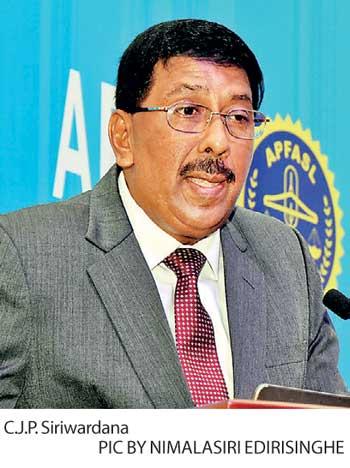20 Feb 2019 - {{hitsCtrl.values.hits}}
 By Nishel Fernando
By Nishel Fernando
Sri Lanka needs a strong medium-term debt management strategy, with a target to reduce its outstanding debt stock to 60 percent of GDP by 2030 with a long-term vision of bringing down the debt to GDP ratio to below 50 percent, according to former Central Bank Deputy Governor and Deputy Secretary General of National Economic Council (NEC), C.J.P. Siriwardana.
While acknowledging that the Active Liability Management Act was an important step towards prudent liability management, he stressed the government needs a holistic approach to enhance all debt dynamics for smooth debt management, as the country’s debt reached 77.6 percent of GDP at the end of 2017, one of the highest in South and South East Asia.
“We have to improve all debt dynamics, which means we have to enhance the economic growth, lower the interest rates, generate surpluses in primary and current accounts in the budget, maintain the stability of exchange,” Siriwardana said.
He made these remarks delivering the keynote address at the Annual Conference of Chartered Public Finance Accountancy (CPFA) & Association of Public Finance Accountants of Sri Lanka (APFASL) held at CA Sri Lanka Auditorium last week.
According to Finance Ministry data, Sri Lanka’s outstanding debt stock stood at Rs 10.9 trillion as of the second quarter, last year. Siriwardana estimated that the country’s debt stock would have been further increased by an additional Rs.100-200 billion due to the rupee’s sharp depreciation last year.
According to the Appropriation Bill, the government plans to borrow Rs.2.1 trillion this year to service the highest ever debt repayments and interest payments as well as to finance the
budget deficit.
Siriwardana estimated that the government’s gross borrowing would be around Rs. 2.7 trillion including rolling over of the Treasury bill stock.
He said the country’s significantly high debt stock is a byproduct of running the economy with continuous budget deficits and loss making State-Owned Enterprises (SOEs), which is further exacerbated by the rupee depreciation.
He pointed out that due to these factors the outstanding government debt stock in the recent past has doubled every 5 years.
Siriwardana emphasised the government should further strengthen the Fiscal Management (Responsibility) Act while reforming the loss-making SOEs which have been a massive burden to State coffers.
He noted that the total outstanding debt of SOEs to the banking sector amounted to Rs.845 billion at the end of 2017.
“This country has been running with 100 public enterprises under State ownership. We need a complete overhaul of these entities in the long run. I know it is a difficult task to achieve immediately.
“In particular, the corporations that are running businesses should be independent and self-sufficient, at least for their survival,” he elaborated.
Siriwardana stressed that the government also needs to focus on long-term sustainability of strategically important SOEs such as Ceylon Electricity Board, Ceylon Petroleum Corporation, SriLankan Airlines, Sri Lanka Ports Authority and Road Development Authority.
He proposed that the government should consider a policy of capital infusion to these institutions through Public-Private Partnerships (PPPs).
He highlighted that the continuation of the fiscal consolidation programme is crucial for Sri Lanka to enhance revenue collection to 16-17 percent of GDP while maintaining the government expenditure around 20 percent of GDP in the medium-term.
Siriwardana opined that further simplification of Sri Lanka’s tax structure and the introduction of new technology in tax collection are vital components to increase government revenue to the targeted 16-17 percent of GDP.
He pointed out that VAT, excise, import tariff and income tax currently contribute to nearly 75 percent of the country’s tax revenue, while a number of other taxes contribute to the rest.
15 Nov 2024 7 hours ago
15 Nov 2024 8 hours ago
15 Nov 2024 9 hours ago
15 Nov 2024 15 Nov 2024
15 Nov 2024 15 Nov 2024